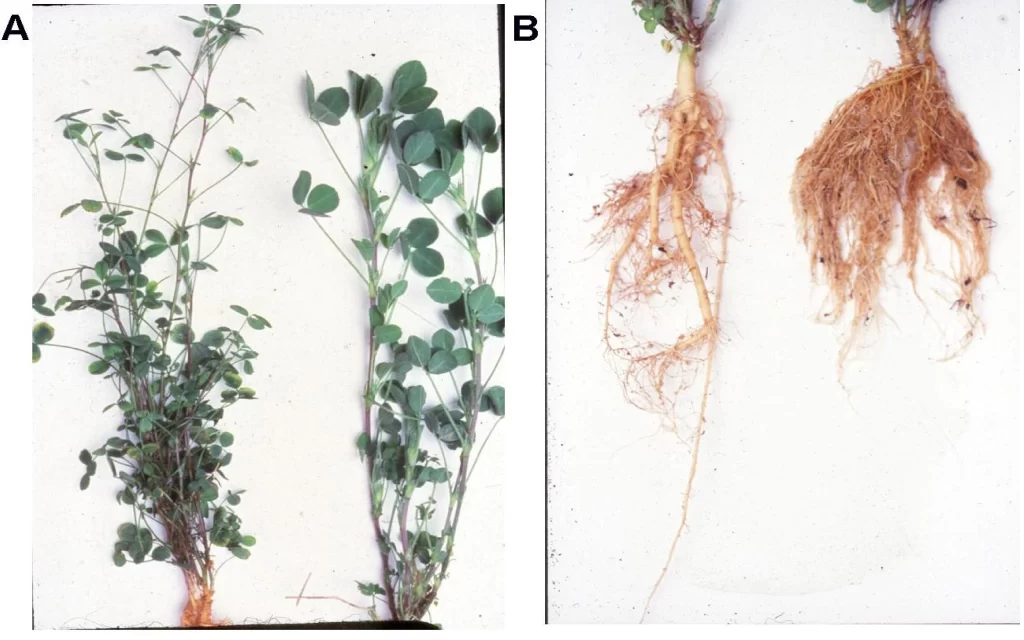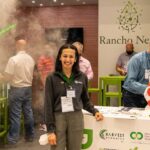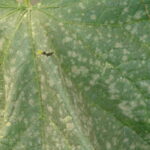
Written by: Becky Anderson
Published by: David Santos
What is Agrobacterium rhizogenes?
Agrobacterium rhizogenes, also currently known as Rhizobium rhizogenes (1), is a Gram-negative, rod shaped, pathogenic bacteria (2) (Figure 1). A. rhizogenes lives in the rhizosphere, which is where the name derived (rhiza a root and gennao to make or to produce; hence, rhizogenes or root-producing). A. rhizogenes causes hairy root disease (HRD), also known as root mat disease, crazy roots, or hairy roots, in flowering plants called dicotyledons (dicots) (4) (Figure 2).
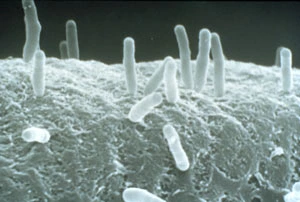
The name change has occurred due to reclassification and advances in taxonomy, however Agrobacterium rhizogenes is the most frequently used name for this species. You may recognize the name Agrobacterium tumefaciens, which is a close relative to A. rhizogenes and is the causative agent of crown gall disease—this will be discussed in the next section (3).
Gram-negative: a group of bacteria which counterstain using the Gram staining method
pathogenic: an organism which causes disease or illness
rhizosphere: the area of soil surrounding the roots of plants
Infection and Symptoms:
Infection naturally occurs by penetrating injured roots (4). Wounded plant cells release phenolic compounds that attract A. rhizogenes, through a method called chemotaxis (3).
phenolic compounds: chemical compounds naturally produced by plants for many reasons from plant defense to chemical signaling. These compounds contain aromatic rings with hydroxy groups that are directly attached to a phenyl, substituted phenyl, or aryl group
chemotaxis: the attraction of an organism toward an environmental stimulant or away from surroundings it considers a repellent
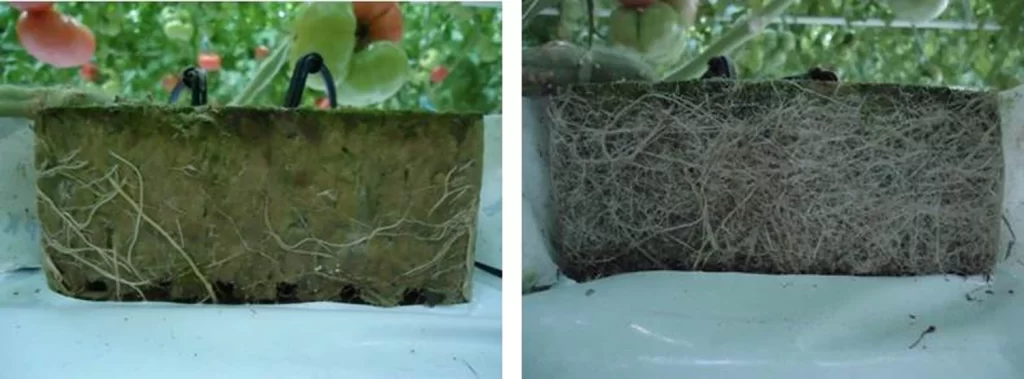
Infection with Agrobacterium occurs when a small piece of mobile DNA (T-DNA), called a Ri-plasmid, or a Ti-plasmid integrates into the plant genome (4). The Ri-plasmid causes root abnormalities (hairy roots) whereas the Ti-plasmid causes tumour growth on stems (crown gall disease) (5). Typically, strains of Agrobacterium which carry the Ri-plasmid are A. rhizogenes and those that carry the Ti-plasmid are A. tumefaciencs (5). Alternatively, non-pathogenic strains of Agrobacterium are typically a third species called A. radiobacter (5).
DNA: deoxyribonucleic acid, contains genetic information responsible for the growth, development, and function of an organism
T-DNA: is the transferred-DNA (Ti or Ri plasmid) from the host bacteria (Agrobacterium) into the plant’s genome
Ri-plasmid: rhizogenic plasmid, which causes root growth (aka hairy root disease)
Ti-plasmid: tumorigenic plasmid, which causes tumor growth (aka crown gall disease)
plasmid: a piece of DNA in a cell that is separate from the chromosome (necessary DNA for the survival of an organism), can move/be transferred between organisms, and can carry beneficial or survival genes.
genome: an organism’s complete set of DNA
We provide great overviews of many agriculture microorganisms. Subscribe to stay updated!
For A. rhizogenes, the integration of this Ri-plasmid genetically modifies the plant and as a result, alters the natural hormonal balances (4). These hormonal changes cause the infected plant to produce abnormal, or hairy roots (4).
genetically modified: the insertion of DNA into an organism’s genome
Infected roots differ from normal healthy roots in that they are longer, more numerous, and highly branched (3). Due to the modification in roots, the plants often grow quicker and larger than normal, but have a reduced fruit production, with a 10% loss in tomato production (1). Infected roots are also more likely to have a secondary infection caused by other pathogens, like pythium or pseudomonas (6).
Growth Conditions:
Table 1. Growth conditions for Agrobacterium rhizogenes
| Variable | Optimal Condition | Additional Notes |
| Environmental | Aerobic, naturally inhabit soil | Cannot grow in 2% NaCl |
| pH | pH 5-9 | The pH of the nutrient solution can help balance the vegetative vs. generative stage of plants, reducing overgrowth of vegetation caused by Agrobacterium and increasing fruit production |
| Temperature | 25-28˚C (77-82.4˚F) |
Cannot grow at temperatures greater than 35˚C |
aerobic: requires oxygen to grow
NaCl: sodium chloride, or salt
A. rhizogenes in hydroponic systems:
Hydroponic plants which are naturally susceptible to A. rhizogenes include tomato, cucumber, and eggplant (1,7). A rhizogenes is very persistent, which means it is likely to reside in the same greenhouse or hydroponic system for years, causing re-infection in subsequent seasons (1). The best way to manage infection and disease is with early detection and quantification (1). Once an infection has occurred and the bacterial DNA has been integrated into the plant genome, infected plants cannot be “cured”, therefore preventative measures (Table 2) are the only approach to avoid disease.
susceptible: an organism’s ability to suffer if exposed to a particular threat.
Table 2. Examples of strategies to prevent infections and habituation of Agrobacterium rhizogenes in hydroponic systems
|
Strategy |
Examples |
Benefits |
Drawbacks |
| Irrigation Techniques | Lower frequency with increased concentrations of nutrient solution | Decreases HRD on rockwool more than coco fibre. |
Highly depends on growth substrate and plant.
|
|
Irrigation Techniques |
Higher frequency with lower concentrations of nutrient solution |
Similar infection results at the end of the growing season, compared to using a lower frequency with high concentrations of nutrients. |
Highly depends on growth substrate and plant. |
| Crop Type | Eggplant | Hydroponic eggplants grown on perlite, compared to rockwool, develop less severe HRD symptoms. | Success of crops depends on multiple factors such as growth substrates and irrigation techniques. |
| Crop Type | Tomatoes |
Hydroponic tomatoes grown on rockwool or peat moss have shown significant improvements to growth. |
Success of crops depends on multiple factors such as growth substrates and irrigation techniques. |
| Substrate Type |
Rockwool |
Can promote generative growth in tomato plants. | Oxygen deprivation in roots can negatively impact growth. |
| Substrate Type |
Peat moss |
Can promote generative growth in tomato plants. |
Oxygen deprivation in roots can negatively impact growth. |
| Disinfection | Hydrogen peroxide |
Can significantly reduce the concentration of A. rhizogenes in the nutrient solution. Hydrogen peroxide is also less hazardous than other options such as chlorine and safer for the environment. |
Many strains of A. rhizogenes are tolerant to H2O2 and therefore high concentrations would be required to have any effect (e.g. 100 ppm for catalase positive bacteria and 50 ppm for catalase negative bacteria). |
| Biocontrol | Introduction of antagonist Paenibacillus xylanilyticus | Has shown promising effects in preventing growth and infection with A. rhizogenes. | This research is in its early stages and although promising, more information is needed before it would be available for use. Could contribute to biofilm formation. |
| Other Treatments | Rootstock grafting |
Can protect against disease and stress. |
Success is highly dependent on plant variety and type of rootstock. |
| Other Treatments |
Leaf pruning |
Can increase the development and production of fruit. |
Labor intensive and not yet proven to significantly reduce HRD symptoms. |
| Other Treatments |
Root pruning |
Can control growth and development of flowers/fruit. |
Labor intensive and not always feasible. |
| Other Treatments |
Nutrient solution modification |
Changing the pH of nutrient solutions can balance generative vs. vegetative growth. |
Limited pH range for growth and requires frequent monitoring and precision to avoid nutrient deprivation. |
This table summarizes research and information provided by Bosmans et al., 2017 and Dannehl et al., 2015. Further descriptions and examples can be found in their original texts, cited below.
Biocontrol: the use of living organisms or natural substances to prevent or control damage caused by harmful organisms, and does not require pesticides
Cultivation methods and techniques can be modified to favour generative (reproductive, fruit producing) over vegetative growth, which can potentially counteract the effect of hairy root disease. Biocontrol methods are still in the early stages of development and research, however P. xylanilyticus has been reported to show promising effects against the proliferation of A. rhizogenes in hydroponic systems (1).
Using Agrobacterium rhizogenes to help the environment:
Although the growth of hairy roots can clog hydroponic systems and cause abnormal plant growth, this feature is being harnessed for biotechnological purposes such as phytoremediation, which uses plants to clean up environmental contamination. The technique for harnessing this growth characteristic is called hairy roots culture (HRC) and can be manipulated to produce secondary metabolites such as alkaloids, terpenoids, phenols, and glycosides (4,9). This characteristic is also being used to study ways to detoxify the environment and increase drought tolerance in plants (3).
biotechnology: the integration of natural science to engineer a product or service
secondary metabolites: not required for growth of an organism, but are produced to provide an advantage to the organism, such as inhibiting growth of a competitive organism
Using HRD as a phytoremediation tool costs 2-5 fold less than traditional capping methods, however, plants cannot clean up toxins that are below the root depth nor can plants survive in environments with too high of toxicity levels (10). Examples of phytoremediation using plants with HRD include the uptake of metals (e.g. zinc, copper, lead) from the environment into stems and leaves, breaking down pollutants such as trichloroethylene or herbicides, utilizing the rhizosphere to break down pollutants and rhizofiltration (10). The latter utilizes the absorption of pollutants through the roots (10). A more in-depth explanation of these examples can be found in the review by Suresh and Ravishankar, 2004.
Disclaimer:
The information we present in Pathogen Profile is based on collating published peer-reviewed scientific literature and sources we think are reliable. This is by no means an exhaustive review of pathogens. Pathogen Profile gives a small glimpse of what is known about pathogens and we encourage growers to do more research on their own based on the pathogens in relation to their own crops and hydroponic systems. The information presented in Pathogen Profile is for educational purposes and should not be used as professional advice to treat pathogens or to operate your hydroponic system.
Works Cited
- Bosmans, L., Moerkens, R., Wittemans, L., De Mot, R., Rediers, H. and Lievens, B. (2017), Rhizogenic agrobacteria in hydroponic crops: epidemics, diagnostics and control. Plant Pathol, 66: 1043-1053. https://doi.org/10.1111/ppa.12687
- Conn, H.J. Validity of the genus Alcaligenes. J Bacteriol 44:353–360; 1942 doi: 10.1128/jb.44.3.353-360.1942
- Veena, V., Taylor, C.G. Agrobacterium rhizogenes: recent developments and promising applications. In Vitro Cell.Dev.Biol.-Plant 43, 383–403 (2007). https://doi.org/10.1007/s11627-007-9096-8
- Yasybaeva G, Vershinina Z, Kuluev B, Mikhaylova E, Baymiev A, Chemeris A 2017 Biolistic-mediated plasmid-free transformation for induction of hairy roots in tobacco plants. Plant Root 11:33-39. doi:10.3117/plantroot.11.33 Copyrights 2017, Plant Root (JSRR), www.plantroot.org (https://www.cabdirect.org/cabdirect/abstract/20183132574)
- Brenner, DJ., Krieg, NR., Staley, JT,. “Bergey’s Manual of Systematic Bacteriology: The Proteobacteria Part C”. Vol.2. Springer. 2005. 340-345.
- Weller SA, Stead DE, Young JPW, 2006. Recurrent outbreaks of root mat in cucumber and tomato are associated with a monomorphic, cucumopine, Ri-plasmid harboured by various Alphaproteobacteria. FEMS Microbiology Letters 258, 136– 43. https://doi.org/10.1111/j.1574-6968.2006.00214.x
- John R. Porter Ph.D. & Hector Flores Ph.D. (1991) Host range and implications of plant infection by Agrobacterium rhizogenes, Critical Reviews in Plant Sciences,10:4, 387-421, DOI: 10.1080/07352689109382318
- Dannehl, D., Suhl, J., Ulrichs, C., y Schmidt, U. (2015). Evaluation of substitutes for rock wool as growing substrate for hydroponic tomato production. Journal of Applied Botany and Food Quality, 88(1). DOI:10.5073/JABFQ.2015.088.010
- Gutierrez-Valdes N, Häkkinen ST, Lemasson C, Guillet M, Oksman-Caldentey K-M, Ritala A and Cardon F (2020) Hairy Root Cultures—A Versatile Tool With Multiple Applications. Front. Plant Sci. 11:33. DOI: 10.3389/fpls.2020.00033
- Suresh, B.; Ravishankar, G.A. Phytoremediation—a novel and promising approach for environmental clean-up. Crit Rev Biotechnol 24:97–124; 2004. DOI: 10.1080/07388550490493627
Looking for more useful info? Go back to the Blog Page or checkout the Resources Page.


